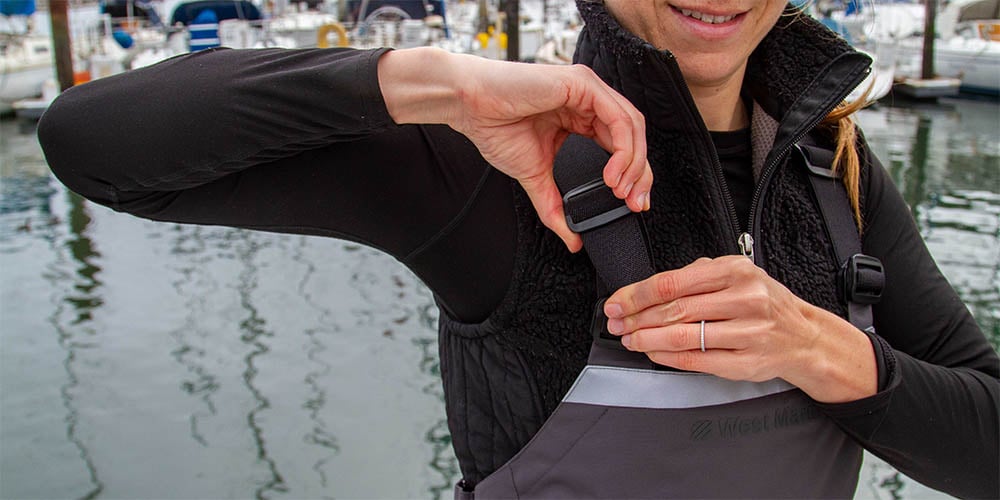
Stay Comfortable in any Weather
Layers of special clothing for active boating, such as foul weather gear, fleece jackets and long underwear, help keep us warm, dry and comfortable regardless of changing weather. We can't always depend on the weather being balmy and inviting when our schedules allow us to spend a day on the water.
Boating weather may range from freezing conditions for New England frostbite to very hot and humid tropical weather for offshore fishing in Miami or cruising in Baja California. Staying comfortable means staying safe.
If you are shivering and using your body's energy to keep warm, if you have cold hands or numb toes, or conversely if the interior of your foul weather jacket feels like a steam bath, your ability to function and make sound decisions may suffer.
You may have difficulty gripping a line or maintaining your balance on a bounding foredeck. Fortunately, wearing the right kind of layered boating gear helps you maintain a pleasant "microclimate" around your body by controlling temperature and moisture.
- Layered Clothing Keeps You Dry
- Three Layers in Modern Tech Gear
- The Base Layer
- The Insulating Layer
- The Weather Protection Layer
- Recommended Additions
- Conclusion
Layered Clothing Keeps You Dry
At rest, your body gives off about 1/4 cup (2 oz.) of sweat per hour. With moderate activity like sail trimming, that amount increases to about a pint per hour. With heavy activity—changing a sail in rough weather or fighting a powerful fish, for example—output increases to a quart per hour and heat becomes a factor, too.
Since water absorbs heat 25 times faster than air of the same temperature, so that wet skin gets cold faster than dry skin, staying dry is a key goal of any system of layered boating clothing. Proper layering helps keep the moisture migrating away from your skin, insulates you appropriately for the conditions, and allows you to shed layers to stay comfortable when you increase your activity level.
Three Layers in Modern Tech Gear
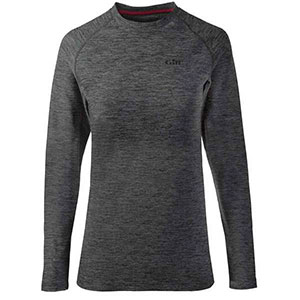
Base layers, like this one from Gill, retain heat and wick away moisture.
Modern clothing systems consist of three layers, used in lots of combinations to control heat transfer and manage moisture. Some combination of layers will be right for just about every condition, whether it's a complete system of wicking and insulating layers worn under waterproof, breathable offshore foul weather gear, or a simple T-shirt and jacket combo using a wind- and spray-proof shelled jacket.
In extreme cold and wet conditions and at varying activity levels, comfort can be improved dramatically through proper layering. Several carefully selected layers of clothes are warmer and more versatile than a single heavy layer.
The Base Layer
Constructed of nonabsorbent stretchy, double-knit synthetic fibers, the base layer or wicking layer is worn next to the skin. Capillary or "wicking" action of this "hydrophobic" or water repelling fabric facilitates the transfer of moisture away from the skin. Wicking allows the body's natural evaporation process to maintain body temperature and preserve a layer of warm, dry air next to the skin-a very important part of staying comfortable. Polyester, nylon and polypropylene are the primary fabrics that are used to create hydrophobic (water repelling), slippery, sheer and very light material. Fabrics such as Dupont's Coolmax® and Henri Lloyd's Fast-Dri are designed to move moisture away from the skin. Our selection of men's baselayers and women's baselayers includes both short and long sleeve tee shirts, and short and long pants.
The traditional fabric, cotton, is inferior to these synthetic fabrics at removing moisture. Wearing a cotton base layer, which absorbs up to 25% of its own weight in water, reduces the effectiveness of high-performance outer layers.
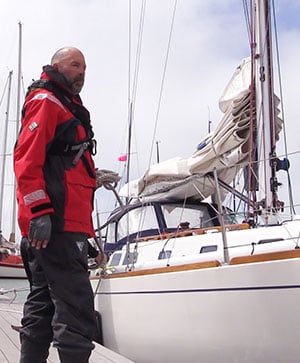
Layered gear I was wearing at the start of a 2000-mile race to Hawaii:
Base layer: Long sleeve technical top, Patagonia Capilene Midweight Long Underwear Bottoms, and Smartwool socks.
Mid layer: West Marine fleece pullover (very old, 1998), REI fleece pants
Outer layer: Kaenon Arlo sunglasses, Musto BR2 Offshore Jacket, BR2 Offshore Bibs, Ronstan 3/4 Finger Sticky Race Gloves Spinlock Deckvest™ PFD with Harness DuBarry Newport Boots with GORE-TEX lining
The Insulating Layer
Worn over the wicking layer, the insulating or mid layer acts as a buffer between warm skin and cold air or foul weather gear fabric. Its job is to reduce heat loss from convection by limiting air circulation, trapping a layer of warm air near the body. Wool, since it retains some insulating ability even when wet, is the traditional insulating layer. Modern synthetic fibers like fleece are even better insulators because they are lighter, dry quickly, pass moisture outward and don't mildew. Densely woven fabrics, like the Polartec family of polyester fleeces maintain a warm layer by trapping air within themselves. The insulating mid layer can be removed as conditions warm up.
Insulating layers are available in three varieties. Windbreakers are very lightweight, and can increase the warmth of layering systems, but have little insulation. Shelled fleece garments combine the wind and water protection of a windbreaker with an inner layer of fleece for warmth. Fleece garments, made of 100% polyester, are ideal insulators. Fleece is soft, lightweight, and has a high warmth-to-weight ratio. Even better, fleece doesn't absorb water, dries quickly, and stays warm, even when wet, making it an exceptional thermal midlayer. It doesn't itch or chafe, so you can wear it next to your skin. It's washable and shrink-proof.
A miracle fabric? Almost. Fleece is not windproof or waterproof. However, some fleece fabrics are now produced with coatings or laminates, such as Polartec Windbloc®, that make garments windproof for added warmth. Others, like Polartec Wind Pro, are made with a tighter weave to block wind penetration. Shelled jackets combine the benefits of windbreakers and fleece. They provide protection from wind and water, and provide warmth. They are stylish, too, which makes them both popular and useful boating garments and casual wear. The insulating inner layer is usually fleece and the outer "shell" is usually nylon treated to reduce wind penetration and repel water.
The Weather Protection Layer
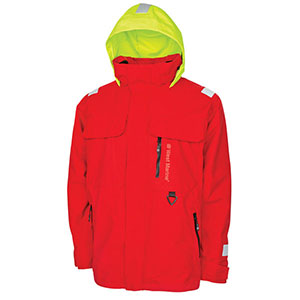
Our Third Reef jackets are lightweight, windproof, waterproof and breathable and are a great addition to your foul weather gear.
The outside layer keeps water and cold air out of the inner insulating layers, and aids them in preserving the temperate microclimate inside your layering system. Your choice of an appropriate exterior layer depends on whether or not rain, snow, spray, or wind is a factor. Stopping wind penetration is relatively simple with the use of a tightly woven material, a coated fabric or a fabric with a wind blocking membrane. Stopping moisture is far more complicated.
Non-breathable foul weather gear keeps water out, but it also traps perspiration vapor inside. Breathable foul weather gear will allow moisture from inside your layering system to pass through to the outside, keeping you dry and comfortable.
Choose a set of breathable foul weather gear that matches the kind of boating you do and the typical conditions you encounter during the season. Do you use your boat only during the day, or do you spend time on deck or in the cockpit at three a.m.? If you regularly operate your vessel on overnight excursions in nasty weather you should consider Offshore-rated equipment, but for daytime-only use, Coastal or Inshore gear may suffice. Highly breathable gear that is easy to adjust is especially important, as perspiration can easily overload your foul weather gear's capacity for shedding moisture when you engage in intense activity. Afterward you will feel cold and clammy. Look for hoods, zippers and cuffs that are easy to adjust. We carry men's foul weather gear and women's foul weather gear to fit any boater and any conditions
Recommended Additions
The extremities, especially the head and neck, are where most of the body's heat loss takes place, so protection is critical for the head, neck, hands and feet. The layering principles apply here, too. Bulk can be a serious negative factor, especially on the hands, so garments combine the functions of several layers. Cold weather gloves use a waterproof, breathable nylon exterior, and are fleece lined for insulation. Palms are reinforced with amara, a synthetic leather that does not curl, shrink or harden, and Kevlar, the material used in bulletproof vests.
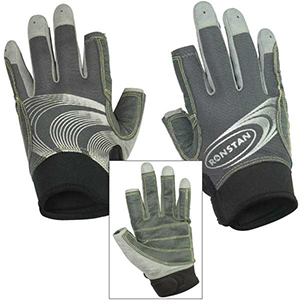
The author is a fan of the Ronstan Sticky Race Gloves.
Wearing insulating head protection can reduce the risk of hypothermia and is essential for keeping warm and comfortable on a cold watch. A fleece cap provides lightweight insulation that dries quickly and keeps you warm, even when wet. I use one during offshore sailing and it is incredibly toasty!
Many boaters have no incentive to spend more for high-tech synthetic socks, and will instead wear cotton. The problem with this approach is that cotton retains moisture, and it is this moisture that causes friction and blisters. For years, many in the healthcare field recommended all-cotton socks to prevent foot problems. This is the biggest myth out there! Cotton absorbs moisture and in socks, that moisture stays next to the foot creating an ideal environment for bacteria and fungi to grow, and for blisters to form. Stay away from all-cotton socks!
Modern socks, like our Smartwool socks, work just like other base layer clothing. They move moisture away from your feet, using hydrophobic yarns that won't absorb perspiration vapor next to your foot, and hydrophilic yarns on the outside to draw moisture out to where it can evaporate, keeping feet warm and dry even during active sports, or while wearing clammy boots.
In Conclusion
Wearing layered clothing helps keep you dry and comfortable, because each layer is only required to do one thing well. A hydrophobic wicking layer of long underwear worn next to the skin disperses perspiration outward. A middle insulating layer traps warm air, providing a barrier from cold outside air or fabric, and helps funnel moisture to the weather protection layer. The breathable outside layer uses hydrophilic, water vapor absorbing coatings or microporous membranes like a heat-driven water pump, allowing water vapor molecules to escape. Solid water molecules are blocked, along with wind, from entering. With each layer performing its designed function you stay dry, warm and alert, however hostile the outside environment.